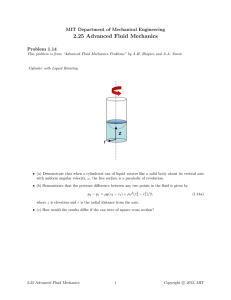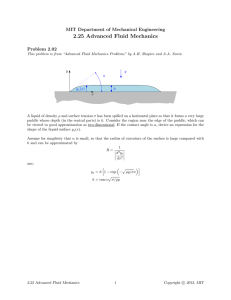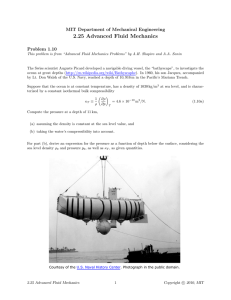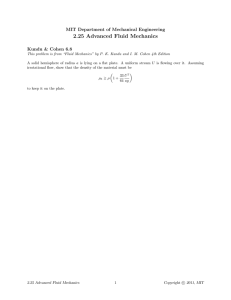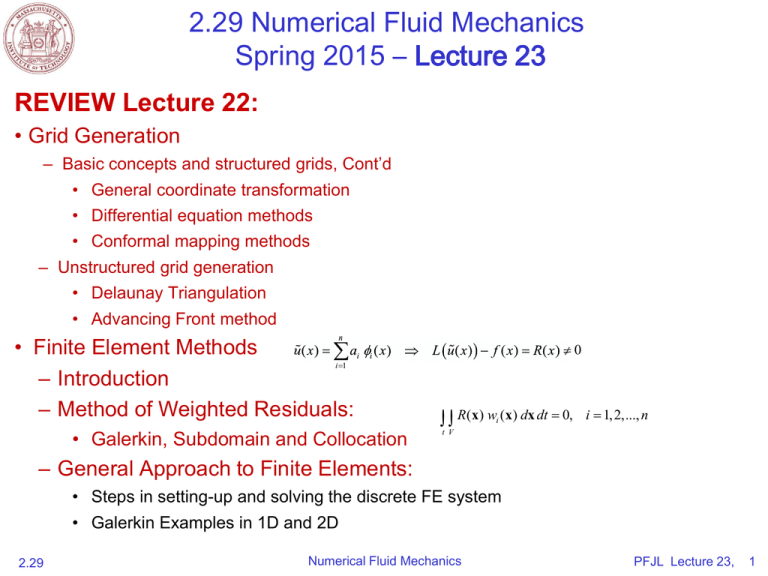
2.29 Numerical Fluid Mechanics
Spring 2015 – Lecture 23
REVIEW Lecture 22:
• Grid Generation
– Basic concepts and structured grids, Cont’d
• General coordinate transformation
• Differential equation methods
• Conformal mapping methods
– Unstructured grid generation
• Delaunay Triangulation
• Advancing Front method
n
• Finite Element Methods
u( x ) a ( x )
– Introduction
– Method of Weighted Residuals:
i 1
i
i
L u( x ) f ( x ) R( x ) 0
• Galerkin, Subdomain and Collocation
x dt
R(x) w (x) d
i
0,
i 1,2,..., n
t V
– General Approach to Finite Elements:
• Steps in setting-up and solving the discrete FE system
• Galerkin Examples in 1D and 2D
2.29
Numerical Fluid Mechanics
PFJL Lecture 23,
1
TODAY (Lecture 23):
Intro. to Finite Elements, Cont’d
• Finite Element Methods
– Introduction
– Method of Weighted Residuals: Galerkin, Subdomain and Collocation
– General Approach to Finite Elements:
• Steps in setting-up and solving the discrete FE system
• Galerkin Examples in 1D and 2D
– Computational Galerkin Methods for PDE: general case
• Variations of MWR: summary
• Finite Elements and their basis functions on local coordinates (1D and 2D)
• Isoparametric finite elements and basis functions on local coordinates (1D, 2D, triangular)
– High-Order: Motivation
– Continuous and Discontinuous Galerkin FE methods:
• CG vs. DG
• Hybridizable Discontinuous Galerkin (HDG): Main idea and example
– DG: Worked simple example
• Finite Volume on Complex geometries
2.29
Numerical Fluid Mechanics
PFJL Lecture 23,
2
References and Reading Assignments
Finite Element Methods
• Chapters 31 on “Finite Elements” of “Chapra and Canale,
Numerical Methods for Engineers, 2006.”
• Lapidus and Pinder, 1982: Numerical solutions of PDEs in
Science and Engineering.
• Chapter 5 on “Weighted Residuals Methods” of Fletcher,
Computational Techniques for Fluid Dynamics. Springer, 2003.
• Some Refs on Finite Elements only:
– Hesthaven J.S. and T. Warburton. Nodal discontinuous Galerkin
methods, vol. 54 of Texts in Applied Mathematics. Springer, New York,
2008. Algorithms, analysis, and applications
– Mathematical aspects of discontinuous Galerkin methods (Di Pietro
and Ern, 2012)
– Theory and Practice of Finite Elements (Ern and Guermond, 2004)
2.29
Numerical Fluid Mechanics
PFJL Lecture 23,
3
General Approach to Finite Elements
1. Discretization: divide domain into “finite elements”
Node 1
– Define nodes (vertex of elements) and nodal lines/planes
(i)
u1
2. Set-up Element equations
i. Choose appropriate basis functions i (x): u( x )
Node 2
u
u2
n
a ( x)
i 1
i
(ii)
i
1
• 1D Example with Lagrange’s polynomials: Interpolating functions Ni (x)
x x
x x1
u a0 a1 x u1N1 ( x ) u2 N 2 ( x ) where N1 ( x ) 2
and N 2 ( x )
x2 x1
x2 x1
• With this choice, we obtain for example the 2nd order CDS and
x2
Trapezoidal rule: d u
u2 u1
u1 u2
u
dx
a
and
( x2 x1 )
1
x
dx
x2 x1
2
1
ii. Evaluate coefficients of these basis functions by approximating
the equations to be solved in an optimal way
N1
(iii)
N2
x1
1
x2
(iv)
(i) A line element
(ii) The shape function or linear
approximation of the line element
(iii) and (iv) Corresponding interpolation
functions.
Image by MIT OpenCourseWare.
• This develops the equations governing the element’s dynamics
• Two main approaches: Method of Weighted Residuals (MWR) or Variational Approach
Result: relationships between the unknown coefficients ai so as to satisfy the PDE in
an optimal approximate way
2.29
Numerical Fluid Mechanics
PFJL Lecture 23,
4
General Approach to Finite Elements, Cont’d
2. Set-up Element equations, Cont’d
– Mathematically, combining i. and ii. gives the element equations: a set of (often
linear) algebraic equations for a given element e:
K e u e fe
where Ke is the element property matrix (stiffness matrix in solids), ue the vector
of unknowns at the nodes and fe the vector of external forcing
3. Assembly:
– After the individual element equations are derived, they must be assembled: i.e.
impose continuity constraints for contiguous elements
– This leas to:
Ku f
where K is the assemblage property or coefficient matrix, u the vector of
unknowns at the nodes and f the vector of external forcing
4. Boundary Conditions: Modify “ K u = f ” to account for BCs
5. Solution: use LU, banded, iterative, gradient or other methods
6. Post-processing: compute secondary variables, errors, plot, etc
2.29
Numerical Fluid Mechanics
PFJL Lecture 23,
5
Galerkin’s Method: Simple Example
Differential Equation
1. Discretization:
Generic N (here 3) equidistant nodes along x,
at x = [0, 0.5,1]
Boundary Conditions
Exact solution: y=exp(x)
2. Element equations:
i. Basis (Shape)
Functions:
Power Series
(Modal basis)
Note: this is
equivalent
to imposing
the BC on
the full sum
2.29
Boundary Condition
In this simple example, a single element is
chosen to cover the whole domain the
element/mass matrix is the full one (K=Ke)
Numerical Fluid Mechanics
PFJL Lecture 23,
6
Galerkin’s Method: Simple Example, Cont’d
ii. Optimal coefficients with MWR: set weighted residuals (remainder) to zero
Remainder:
dy
y
dx
R
N=3;
d=zeros(N,1);
m=zeros(N,N);
for k=1:N
d(k)=1/k;
for j=1:N
m(k,j) = j/(j+k-1)-1/(j+k);
end
end
a=inv(m)*d;
y=ones(1,n);
for k=1:N
y=y+a(k)*x.^k
end
exp_eq.m
Galerkin set remainder orthogonal to each shape function:
1
Denoting inner products as: ( f , g ) f , g f g dx
0
( R,
x k 1 ) 0,
k 1,..., N
leads to:
which then leads to the Algebraic Equations:
k 1,..., N
j 1,..., N
j
2.29
Numerical Fluid Mechanics
PFJL Lecture 23,
7
Galerkin’s Method Simple Example, Cont’d
3 - 4. Assembly and boundary conditions:
Already done (element fills whole domain)
5. Solution:
For
BCs already set
N=3;
d=zeros(N,1);
m=zeros(N,N);
for k=1:N
d(k)=1/k;
for j=1:N
m(k,j) = j/(j+k-1)-1/(j+k);
end
end
a=inv(m)*d;
y=ones(1,n);
for k=1:N
y=y+a(k)*x.^k
end
exp_eq.m
L2 Error:
2.29
Numerical Fluid Mechanics
PFJL Lecture 23,
8
Comparisons with other
Weighted Residual Methods
Least Squares
Subdomain Method
Collocation
Galerkin
2.29
Numerical Fluid Mechanics
PFJL Lecture 23,
9
Comparisons with other
Weighted Residual Methods
Comparison of coefficients for approximate
solution of dy/dx - y = 0
Scheme
Coefficient
Least squares
Galerkin
Subdomain
Collocation
Taylor series
Optimal L2,d
a1
a2
a3
1.0131
1.0141
1.0156
1.0000
1.0000
1.0138
0.4255
0.4225
0.4219
0.4286
0.5000
0.4264
0.2797
0.2817
0.2813
0.2857
0.1667
0.2781
Image by MIT OpenCourseWare.
Comparison of approximate solutions of dy/dx - y = 0
Taylor
series
Optimal
L2,d
Exact
1.0000
1.0000
1.0000
1.0000
1.2223
1.2194
1.2213
1.2220
1.2214
1.4917
1.4869
1.4907
1.4915
1.4918
1.8220
1.8160
1.8160
1.8219
1.8221
Least
squares
Galerkin
0
1.0000
1.0000
1.0000
0.2
1.2219
1.2220
0.4
1.4912
1.4913
0.6
1.8214
1.8214
x
Subdomain Collocation
0.8
2.2260
2.2259
2.2265
2.2206
2.2053
2.2263
2.2255
1.0
2.7183
2.7183
2.7187
2.7143
2.6667
2.7183
2.7183
0.00105
0.00103
0.00127
0.0094
0.0512
0.00101
ya - y
2,d
Image by MIT OpenCourseWare.
2.29
Numerical Fluid Mechanics
PFJL Lecture 23,
10
Galerkin’s Method in 2 Dimensions
Differential Equation
y
Boundary Conditions
n(x,y2)
Shape/Test Function Solution (uo satisifies BC)
j
Remainder (if L is linear Diff. Eqn.)
n(x1,y)
n(x2,y)
j
Inner Product:
n(x,y1)
Galerkin’s Method
x
2.29
Numerical Fluid Mechanics
PFJL Lecture 23,
11
Galerkin’s method: 2D Example
Fully-developed Laminar Viscous Flow in Duct
y
Steady, Very Viscous, fully-developed
Fluid Flow in Duct
1
-1
1
Non-dimensionalization, yields a Poisson Equation:
Shape/Test Functions
x
-1
Shape/Test functions satisfy boundary conditions
4 BCs: No-slip (zero flow) at the walls
2.29
Again: in this example, single
element fills the whole domain
Numerical Fluid Mechanics
PFJL Lecture 23,
12
Galerkin’s Method: Viscous Flow in Duct, Cont’d
x=[-1:h:1]';
y=[-1:h:1];
n=length(x); m=length(y); w=zeros(n,m);
Nt=5;
for j=1:n
xx(:,j)=x; yy(j,:)=y;
end
for i=1:2:Nt
for j=1:2:Nt
w=w+(8/pi^2)^2*
(-1)^((i+j)/2-1)/(i*j*(i^2+j^2))
*cos(i*pi/2*xx).*cos(j*pi/2*yy);
end
end
duct_galerkin.m
Remainder:
Inner product (set to zero):
k, ℓ
Analytical Integration:
Galerkin Solution:
Nt=5 3 terms in
each direction
Flow Rate:
2.29
Numerical Fluid Mechanics
PFJL Lecture 23,
13
Computational Galerkin Methods:
Some General Notes
Differential Equation:
Residuals
Boundary problem
• PDE:
• PDE satisfied exactly
• Boundary Element Method
• Panel Method
• Spectral Methods
• ICs:
• BCs:
Inner problem
• Boundary conditions satisfied exactly
• Finite Element Method
• Spectral Methods
Global Shape/Test Function:
Time Marching + spatial discretization (separable):
Mixed Problem
•Finite Element Method
Weighted Residuals
2.29
Numerical Fluid Mechanics
PFJL Lecture 23,
14
Different forms of the
Methods of Weighted Residuals: Summary
Inner Product
Discrete Form
k 1,2,..., n
Subdomain Method:
R(x) dx dt 0
t Dk
Collocation Method:
R( x k ) 0
Least Squares Method:
R(x) R(x)dx dt 0
ai t Vk
In the least-square method, the coefficients are
adjusted so as to minimize the integral of the residuals.
It amounts to a continuous form of regression.
Method of Moments:
Galerkin:
2.29
In Galerkin, weight functions are basis functions: they sum to
one at any position in the element. In many cases, Galerkin’s
method yields the same result as variational methods
Numerical Fluid Mechanics
PFJL Lecture 23,
15
How to obtain solution for Nodal Unknowns?
Modal ϕk vs. Nodal (Interpolating) Nj Basis Fcts.
N
u( x, y )
u j N j ( x, y )
1 Dimension
j 1
N
u( x, y )
ak k ( x, y )
k 1
N
uj
ak k ( x j , y j )
k 1
2 Dimensions
u Φ a a Φ1 u
N
1
u( x, y )
Φ kj u j k ( x, y )
k 1
j1
N
N
N
u j Φ1 k ( x, y )
kj
j 1
k 1
N
N j ( x, y )
Φ1 k ( x, y )
k 1
2.29
kj
Numerical Fluid Mechanics
PFJL Lecture 23,
16
Finite Elements
1-dimensional Elements
Trial Function Solution
Trial Function Solution
Interpolation (Nodal) Functions
(a)
u
ua
ua
1.0
ua2
u
x1
(b)
N
u~ = � Nj(x)uj
Element A Element B Element C
N2 =
ua
x2
x - x3
x2 - x 3
Element B
u
x - x2
x3 - x 2
x - x4
N3 =
x3 - x4
x2
x3
N2 =
x - x1
x2 - x1
N2 =
x - x3
x2 - x3
N3 =
x - x2
x3 - x2
N3 =
x - x4
x3 - x4
x4
x
N3 =
N(x) N2 = x - x1
x2 - x 1
x1
Interpolation Functions
ua3 ua
x3
j=1
x
x4
Image by MIT OpenCourseWare.
3
Two functions per element
2.29
Numerical Fluid Mechanics
PFJL Lecture 23,
17
Finite Elements
1-dimensional Elements
Quadratic Interpolation (Nodal) Functions
One-dimensional quadratic shape functions
Element A
1.0
Element B
N3
N2
N4
N(x)
0
x1
x2
x3
x4
x
x5
Image by MIT OpenCourseWare.
Three functions per element
4
2.29
Numerical Fluid Mechanics
PFJL Lecture 23,
18
Complex Boundaries
Isoparametric Elements
Isoparametric mapping at a boundary
Y
4
X
�
� = −1
C
4
A
B
�=1
�
B
3
D
3
�=1
2
1
� = −1
2
1
Image by MIT OpenCourseWare.
2.29
Numerical Fluid Mechanics
PFJL Lecture 23,
19
Finite Elements in 1D:
Nodal Basis Functions in the Local Coordinate System
© Wiley-Interscience. All rights reserved. This content is excluded from our Creative
Commons license. For more information, see http://ocw.mit.edu/help/faq-fair-use/.
Source: pp. 63-65 in Lapidus, L., and G. Pinder. Numerical Solution of Partial
Differential Equations in Science and Engineering. 1st ed. Wiley-Interscience,
1982. [Preview with Google Books].
2.29
Numerical Fluid Mechanics
PFJL Lecture 23,
20
Finite Elements
2-dimensional Elements
4
3
η=1
η
ξ = −1
ξ=1
ξ
B
1
η = −1
2
Bilinear shape function on a rectangular grid
Image by MIT OpenCourseWare.
Image by MIT OpenCourseWare.
Linear Interpolation (Nodal) Functions
-
Quadratic Interpolation (Nodal) Functions
corner
nodes
side
nodes
interior
node
2.29
Numerical Fluid Mechanics
PFJL Lecture 23,
21
Finite Elements in 2D:
Nodal Basis Functions in the Local Coordinate System
© Wiley-Interscience. All rights reserved. This content is excluded from our
Creative Commons license. For more information, see http://ocw.mit.edu/fairuse.
2.29
Numerical Fluid Mechanics
PFJL Lecture 23,
22
Finite Elements in 2D:
Nodal Basis Functions in the Local Coordinate System
© Wiley-Interscience. All rights reserved. This content is excluded from our Creative
Commons license. For more information, see http://ocw.mit.edu/help/faq-fair-use/.
Source: Table 2.7A in Lapidus, L., and G. Pinder. Numerical Solution of Partial
Differential Equations in Science and Engineering. 1st ed. Wiley-Interscience, 1982.
[Preview with Google Books].
2.29
Numerical Fluid Mechanics
PFJL Lecture 23,
23
Two-Dimensional Finite Elements
Example: Flow in Duct, Bilinear Basis functions
Finite Element Solution
y2
Integration by Parts
dx=
dx
(for center nodes)
Algebraic Equations for center nodes
2.29
Numerical Fluid Mechanics
PFJL Lecture 23,
24
Finite Elements
2-dimensional Triangular Elements
u
Triangular Coordinates
u1
x
Linear Polynomial Modal Basis Functions:
u3
u( x, y ) a0 a1,1 x a1,2 y
u2
y
(i)
N1
u1 ( x, y ) a0 a1,1 x1 a1,2 y1
1 x1
u2 ( x, y ) a0 a1,1 x2 a1,2 y2 1 x2
1 x3
u3 ( x, y ) a0 a1,1 x3 a1,2 y3
y1
y2
y3
a0 u1
a1,1 u2
a1,2 u3
1
x
y
0
0
(ii)
N2
Nodal Basis (Interpolating) Functions:
0
u( x, y ) u1 N1 ( x, y ) u2 N 2 ( x, y ) u3 N 3 ( x, y )
y
x
1
0
(iii)
N1 ( x , y )
1
( x2 y3 x3 y2 ) ( y2 y3 ) x ( x3 x2 ) y
2 AT
1
N 2 ( x, y )
( x3 y1 x1 y3 ) ( y3 y1 ) x ( x1 x3 ) y
2 AT
1
N 3 ( x, y )
( x1 y2 x2 y1 ) ( y1 y2 ) x ( x2 x1 ) y
2 AT
2.29
Numerical Fluid Mechanics
N3
0
x
1
y
0
(iv)
A linear approximation function (i) and
its interpolation functions (ii)-(iv).
Image by MIT OpenCourseWare.
PFJL Lecture 23,
25
HIGHER-ORDER:
INCREASED ACCURACY FOR SAME EFFICIENCY
Equation:
𝜕𝜙
𝜕𝑡
+𝑐
𝜕𝜙
=0
𝜕𝑥
Low order
Polynomial degree = 0
30 elements
High order
Polynomial degree = 1
15 elements
Φ
Φ
Polynomial degree = 5
5 elements
Φ
Equal degrees
of freedom
(Approx. equal
computational.
efficiency)
x
•
x
Higher-order and low-order should be compared:
– At the same accuracy (most comp. efficient scheme wins)
– At the same comp. efficiency (most accurate scheme wins)
•
x
Rarely done jointly
in literature, difficult
Higher-order can be more accurate for the same comp. efficiency
26
•
~19 tidal cycles (8.5 days)
Mean flow + daily tidal cycle
Two discretizations of similar cost
–
–
6th order scheme on coarse mesh
2nd order scheme on fine mesh
P=5, O(Δx6)
21,000 DOFs
P=1, O(Δx2)
67,200 DOFs
•
Numerical diffusion of lower-order
scheme modifies the concentration
of biomass in patch
High Order
Low Order
Difference
Total Biomass
True Limit cycle
from parameters
Low-Order
–
–
Difference
Biological patch (NPZ model)
Phytoplankton
•
MODELING OF
High-Order
ACCURATE NUMERICAL
PHYTOPLANKTON
© Springer-Verlag. All rights reserved. This content is excluded from our Creative
Commons license. For more information, see http://ocw.mit.edu/help/faq-fair-use/.
Source: Ueckermann, Mattheus P., and Pierre FJ Lermusiaux. "High-order Schemes
for 2D Unsteady Biogeochemical Ocean Models." Ocean Dynamics 60, no. 6 (2010):
1415-45.
(Ueckermann and Lermusiaux, OD, 2010)
27
DISCONTINUOUS GALERKIN (DG)
FINITE ELEMENTS
•
The basis can be continuous or discontinuous across elements
nb
basis
(x,t) h (x,t) i (t) i (x))
•
•
i1
CG: Continuous Galerkin
DG: Discontinuous Galerkin
Main challenge with DG:
Defining numerical flux
•
Advantages of DG:
ˆ f ( , )
© source unknown. All rights reserved. This content is excluded from our Creative
Commons license. For more information, see http://ocw.mit.edu/help/faq-fair-use/.
– Efficient data-structures for parallelization and computer architectures
– Flexibility to add stabilization for advective terms (upwinding, Riemann solvers)
– Local conservation of mass/momentum
•
Disadvantages:
– Difficult to implement
– Relatively new (Reed and Hill 1978, Cockburn and Shu 1989-1998)
• Standard practices still being developed
– Expensive compared to Continuous Galerkin for elliptic problems
– Numerical stability issues due to Gibbs oscillations
28
HYBRID DISCONTINUOUS GALERKIN (HDG)
COMPUTATIONALLY COMPETITIVE WITH CG
Biggest concern with DG: Efficiency for elliptic problems
•
For DG, unknowns are duplicated at edges of element
CG
DG
HDG
•
•
HDG is competitive to CG while retaining properties of DG
HDG parameterizes element-local solutions using new edge-space λ
Nguyen et al. (JCP2009)
Cockburn et al. (SJNA2009)
Key idea: Given initial and boundary conditions for a
domain, the interior solution can be calculated (with
HDG, also in each local element)
Continuity on the edge space of:
• Fields
• Normal component of total fluxes, e.g. numerical
trace of total stress
© source unknown. All rights reserved. This content is excluded from our Creative
Commons license. For more information, see http://ocw.mit.edu/help/faq-fair-use/.
29
Next-generation CFD for Regional Ocean Modeling:
Hybrid Discontinuous Galerkin (HDG) FEMs
The Lock
Exchange
Problem:
Gr=1.25e7
DG – Worked Example
• Choose function space
Original eq. :
MWR :
Integrate by parts :
Divergence theorem,
leads to “weak form” :
2.29
Numerical Fluid Mechanics
PFJL Lecture 23,
31
DG – Worked Example, Cont’d
Substitute basis and test
functions, which are the same
for Galerkin FE methods
Weak form :
Shape fcts. :
Basis fcts. :
Final FE eq. :
2.29
Numerical Fluid Mechanics
PFJL Lecture 23,
32
DG – Worked Example, Cont’d
• Substitute for matrices
– M- Mass matrix
– K- Stiffness or Convection matrix
• Solve specific case of 1D eq.
Euler time-integration :
Fluxes: central with upwind :
2.29
Numerical Fluid Mechanics
PFJL Lecture 23,
33
DG – Worked Example - Code
clear all, clc, clf, close all
syms x
%create nodal basis
%Set order of basis function
%N >=2
N = 3;
%Create basis
if N==3
theta = [1/2*x^2-1/2*x;
1- x^2;
1/2*x^2+1/2*x];
else
xi = linspace(-1,1,N);
for i=1:N
theta(i)=sym('1');
for j=1:N
if j~=i
theta(i) = ...
theta(i)*(x-xi(j))/(xi(i)-xi(j));
end
end
end
end
2.29
%Create mass matrix
for i = 1:N
for j = 1:N
%Create integrand
intgr = int(theta(i)*theta(j));
%Integrate
M(i,j) =...
subs(intgr,1)-subs(intgr,-1);
end
end
%create convection matrix
for i = 1:N
for j = 1:N
%Create integrand
intgr = ...
int(diff(theta(i))*theta(j));
%Integrate
K(i,j) = ...
subs(intgr,1)-subs(intgr,-1);
end
end
Numerical Fluid Mechanics
PFJL Lecture 23,
34
DG – Worked Example – Code Cont’d
%% Initialize u
Nx = 20;
dx = 1./Nx;
%Multiply Jacobian through mass matrix.
%Note computationl domain has length=2,
actual domain length = dx
M=M*dx/2;
%Create "mesh"
x = zeros(N,Nx);
for i = 1:N
x(i,:) =...
dx/(N-1)*(i-1):dx:1-dx/(N-1)*(N-i);
end
%Initialize u vector
u = exp(-(x-.5).^2/.1^2);
%Set timestep and velocity
dt=0.002;
c=1;
%Periodic domain
ids = [Nx,1:Nx-1];
2.29
%Integrate over time
for i = 1:10/dt
u0=u;
%Integrate with 4th order RK
for irk=4:-1:1
%Always use upwind flux
r = c*K*u;
%upwinding
r(end,:) = r(end,:) - c*u(end,:);
%upwinding
r(1,:) = r(1,:) + c*u(end,ids);
%RK scheme
u = u0 + dt/irk*(M\r);
end
%Plot solution
if ~mod(i,10)
plot(x,u,'b')
drawnow
end
end
end
Numerical Fluid Mechanics
PFJL Lecture 23,
35
MIT OpenCourseWare
http://ocw.mit.edu
2.29 Numerical Fluid Mechanics
Spring 2015
For information about citing these materials or our Terms of Use, visit: http://ocw.mit.edu/terms.


